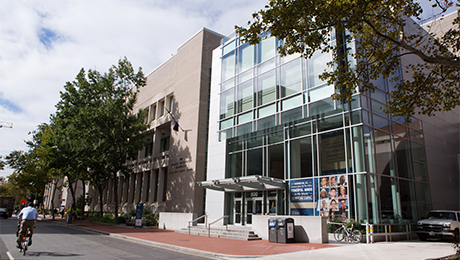The George Washington University announced Monday that the Center for Alcohol and other Drug Education (CADE) will relocate to a centralized wellness space on the ground floor of the Marvin Center, located at 800 21st St. on the Foggy Bottom Campus.
The combined location will also house the University Counseling Center and Student Health Service to better serve the student community. It is scheduled to open at the beginning of 2015.
CADE will continue to provide education, intervention and prevention resources to students for alcohol and other drug issues at the combined location, which will be accessible on the entrance level and main floor of the current GW Campus Store.
The university also announced “Buff and Blue on Penn” on Monday, a new GW-branded apparel and gift shop, located at 2100 Pennsylvania Ave., for Colonial fans, students, parents, faculty, staff and friends of the university.
The GW Campus Store will continue to stock course materials, textbooks, school supplies and GW-branded gear on the lower level of Marvin Center. The GW Technology Hub will move to the former STA Travel space on the ground floor of the Marvin Center, near Colonial Central.
The three store locations, operated by the Follett Higher Education Group, will be open at the start of the fall semester. Information regarding store hours can be found online.
Architecture firm SmithGroup JJR has completed the design phase of the wellness center, and construction on the main space will begin prior to the start of the fall 2014 semester.
Director of Campus Development Management Adam Aaronson said that the centralized student wellness center will include significantly expanded square footage, additional medical and counseling examination rooms, meeting rooms for students and student groups, a meditation room and a resource library.
“The design is focused on providing a welcoming place for students to receive care in a private setting,” Mr. Aaronson said.
CADE offers students a variety of prevention resources, training and programming, including Be Wiser Day, an annual event in support of National Collegiate Alcohol Awareness Week and George’s Heroes, a workshop that teaches students to be active bystanders who intervene when their peers exhibit potentially dangerous behavior in social situations.
CADE also received a $10,000 grant in March from Transforming Youth Recovery (TYR) and the Stacie Mathewson Foundation to support Students for Recovery and campus-wide recovery outreach.
“During our research into integrated health centers at other schools, we found that most included an office dedicated to health promotion that provided educational resources about alcohol and other drugs,” Senior Associate Dean of Students Mark Levine said. “This project has been an exciting opportunity to expand our thinking and consider the many collaborations around substance abuse prevention and interventions that will now be possible because of the combined wellness space.”
Associate Director of CADE Alexis Janda said that the added benefits of the move are increased visibility for student resources and continuity of care between offices.
“CADE is a resource for all students, not just those with abuse or dependence issues,” Ms. Janda said. “We exist to help students make healthy decisions so that alcohol and other drugs don’t have a negative impact on their GW experience. Moving to this new space will encourage students to see CADE as a wellness resource rather than a regulatory office.”
“Many times issues with alcohol and other drugs are connected to mental or physical health issues,” she added. “Having all resources located in one place will help students connect with all three offices so that we can assist them individually and collaboratively.”
Ms. Janda and Mr. Levine have been working closely with the project committee convened by GW President Steven Knapp in fall 2013.
Committee members include Mr. Levine, Student Health Service Medical Director Isabel Goldenberg, Senior Associate Vice President for Operations Alicia Knight, Associate Vice President for Events and Venues Michael Peller, Student Association President Nick Gumas, graduate student and Presidential Administrative Fellow Meredith Waters, University Counseling Center Director Silvestro Weisner and Vice Provost and Dean of Student Affairs Peter Konwerski.
“The migration of these critical services will help the university enhance programming and support for the student wellness experience,” Dr. Konwerski said. “It will also allow us to take a comprehensive look at ways to improve health outreach and education programs to better address the needs of the student community on campus.”
Mr. Gumas said the space will be “tremendously beneficial” to the student body.
“The center will foster greater collaboration between the three offices,” Mr. Gumas said. “It will also allow a greater number of students to be served.”
Students can continue to engage with SHS, UCC and CADE during the fall semester at their current locations during their regular business hours. Information regarding scheduling appointments, upcoming programming and resources are available on their respective websites.


